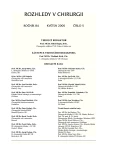Experimental Use of the Peritoneal Graft as a Vascular Prosthesis
Authors:
S. Rokošný 1; J. Kišš 3; P. Wohlfahrt 3; P. Baláž 2; I. Matia 2; T. Štefan 3; M. Pomfy 3
Authors‘ workplace:
Klinika kardiochirurgie, Institut klinické a experimentální medicíny, Praha
přednosta kliniky prof. MUDr. J. Pirk, DrSc.
1; Klinika transplantační chirurgie, Institut klinické a experimentální medicíny, Praha
přednosta kliniky doc. MUDr. M. Adamec, CSc.
2; Ústav histológie a embryológie LF UPJŠ, Košice, prednosta ústavu prof. MVDr. M. Pomfy, CSc.
3
Published in:
Rozhl. Chir., 2005, roč. 84, č. 5, s. 228-232.
Category:
Monothematic special - Original
Overview
Introduction:
The parietal peritoneum appears to be a suitable material for the vascular system reconstructions.
Aim:
The aim was to assess and compare thrombogenicity and ability for endothelization of the mesothelial and submesothelial side of the parietal peritoneum in the canine venous system.
Material and Methodology:
Experimental animals: canis familiaris (n = 13), half-breeds of both sexes, aged between 1 and 2 years, weighting 15–25kgs, underwent authological transplantations of the peritoneal grafts with the mesothelial side in the lumen - the group M (n = 5) and with the submesothelial side in the lumen – the group S (n = 5). In the control group K (n = 3) a part of the venous wall was used as a graft and was affixed back to its original place. The bioptic samples collected on the 10th, 20th, 30th and 40th postoperative day (POD) were stained using the HE staining, NADPH-d and imunohistochemically on the intermedial filaments. The endothelization rate of the peritoneal graft was measured using morphometry and the trombogenicity was assessed peroperatively.
Results:
In none of the trial groups a presence of thrombi was detected peroperatively. In the first trial group (group M), the onset of the peritoneal graft epithelization (reaching 20%) was recorded on the 10th POD. The endothelization process was completed on the 30th POD in this trial group. In the second trial group (group S), the peritoneal graft epithelization reaching 10% was recorded on the 10th POD. The process was completed on the 40th POD. In the third trial group K, no endothelial changes were recorded during the experiment.
Conclusion:
Both sides of the peritoneum do not show signs of thrombogenicity and possess ability for endothelization.
Key words:
peritoneum – endothelization – mesothelium – reconstruction
Labels
Surgery Orthopaedics Trauma surgeryArticle was published in
Perspectives in Surgery

2005 Issue 5
Most read in this issue
- Postcathetrisation Pseudoaneurysm of the Radial Artery
- Elective Open Appendectomy versus Elective Laparoscopic Appendectomy in Women. A Retrospective Study
- The Pedicled Rectus Femoris Muscle Flap for Reconstruction of Complicated Abdominal Wall Defects
- Minimally Invasive Saphenous Vein Harvesting for Coronary Artery Bypass Grafting. Use of Vega System®
